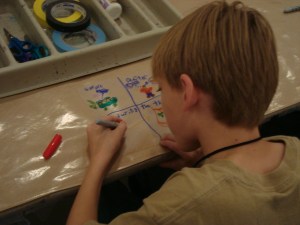For those educators who cannot get enough of the DMA this summer, we have many professional development opportunities for you! With a possibility of earning over sixty CPE credit hours, these sessions are open to K-12 educators across all disciplines and schools. We hope to see you at one or more of the sessions listed below.
 Summer Seminar 2011: Teaching for Creativity
Summer Seminar 2011: Teaching for Creativity
June 14 – 17, 2011, 9:00 a.m. – 4:00 p.m. daily
24 CPE Hours; limit fifteen
Registration is due May, 30, 2011
Designed for teachers of all grade levels and subjects, Summer Seminar is an immersive experience in the Dallas Museum of Art’s galleries and Center for Creative Connections. Conversations, experiences with works of art in the Dallas Museum of Art’s galleries, and creative thinking techniques will be used to create an enriching experience for teachers and models for use in the classroom.
 North American Wildlife at the Dallas Zoo and in the “Art of the American Indians: The Thaw Collection” at the Dallas Museum of Art
North American Wildlife at the Dallas Zoo and in the “Art of the American Indians: The Thaw Collection” at the Dallas Museum of Art
Friday, July 15, 2011, 9:00 a.m.–4:30 p.m.
6 CPE hours; limit thirty
Teachers will explore the relationships between American Indian cultures and native North American wildlife. Participants will closely observe animals at the Dallas Zoo and will study works of art in the Dallas Museum of Art’s exhibition Art of the American Indians: The Thaw Collection.
 Museum Forum for Teachers: Modern & Contemporary Art
Museum Forum for Teachers: Modern & Contemporary Art
July 25- July 29, 2011, 10:00 a.m.-4:00 p.m. daily
30 CPE Hours; limited to twenty-five middle and high school teachers; application is due May, 23, 2011
Teachers will deepen their understanding of contemporary art and architecture through gallery experiences and discussions. Participants will spend each day at one of five area institutions: Modern Art Museum of Fort Worth, Kimbell Art Museum, Dallas Museum of Art, Nasher Sculpture Center, and The Rachofsky House.
 Art of the American Indians: The Thaw Collection
Art of the American Indians: The Thaw Collection
August 9, 2011, 9:00 a.m.–12:30 p.m.
3.5 CPE hours; limit twenty-five
Explore the belief systems of American Indian cultures through artworks in the Art of the American Indians: The Thaw Collection exhibition.
Please note that the Dallas Museum of Art is accredited by the Texas State Board for Educator Certification, and participating educators will earn Continuing Professional Education (CPE) hours during Teacher Workshops, Summer Seminar, and Museum Forum.
Until next time….
Jenny Marvel
Manager of Programs and Resources for Teachers





















